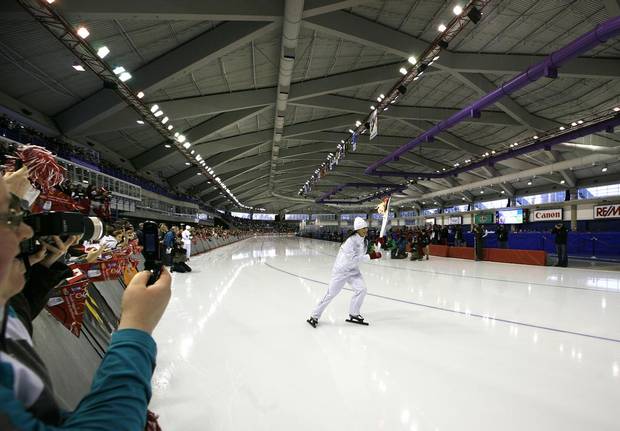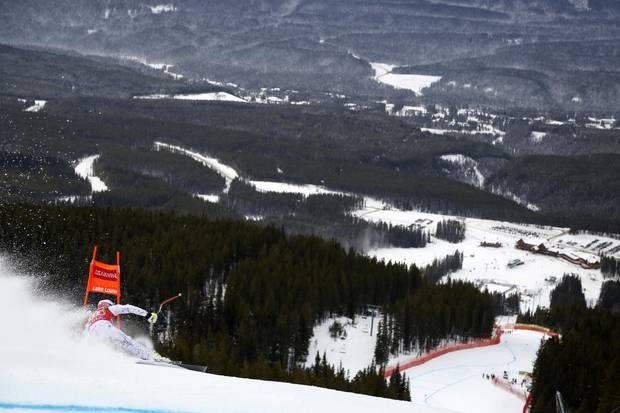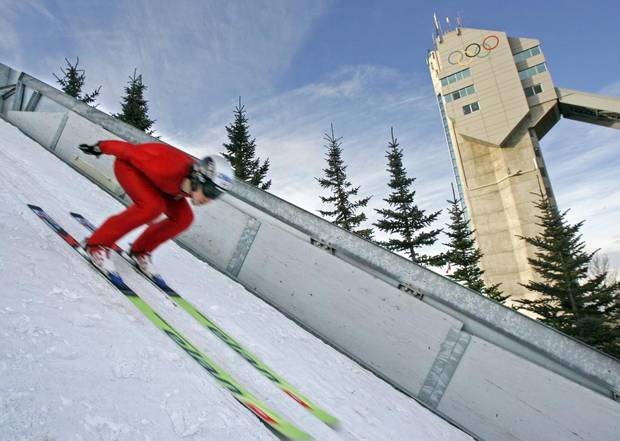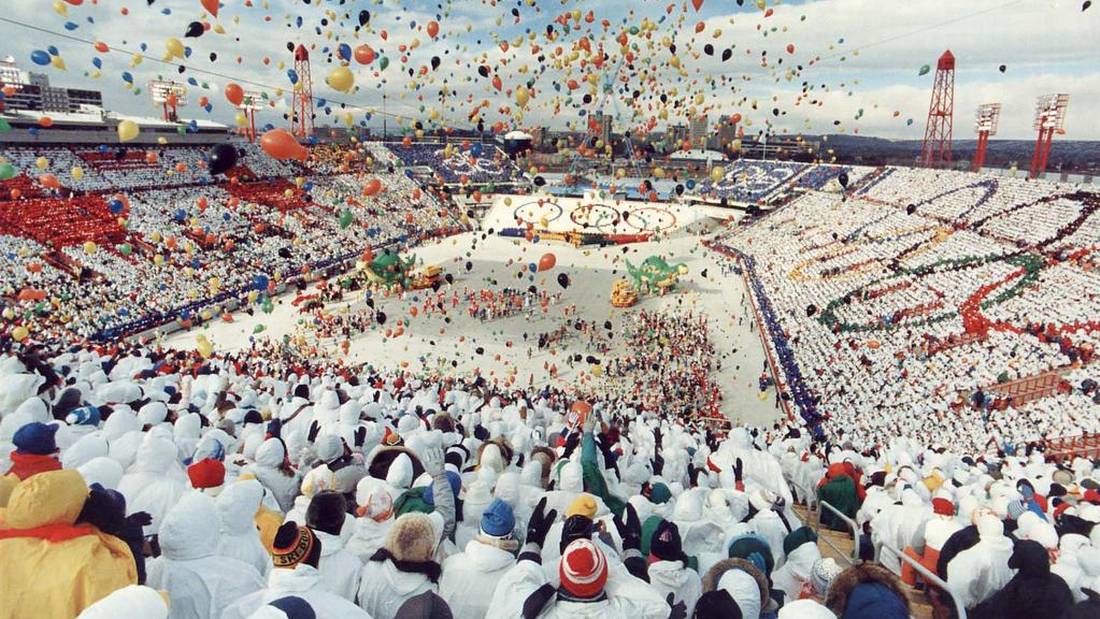About two-thirds of the money needed to renovate and build venues necessary for Calgary to host the 2026 Winter Olympics would be spent upgrading two privately controlled ski resorts and on facilities that would either be torn down or leave little benefit to the city and surrounding area after the Games, The Globe and Mail has found after examining the master plan recommended to city council.
The Olympic bid exploration committee's capital budget to prepare 14 venues for the Games rings in at $391.82-million. Thirteen of the facilities in the master plan require an infusion of cash, the committee said. The one that does not need extra money does not yet exist.
City council voted 9-4 Wednesday to continue examining the feasibility of hosting the Winter Olympics, which would be Calgary's second in 38 years. After considering a report from the bid exploration committee, city administrators said this week that more information – and justification – is needed to determine the usefulness of the proposed new sporting venues and how spending would alter existing facilities.
Related: Calgary city council votes to continue exploring 2026 Winter Olympics bid
Related: Calgary capable of hosting Olympics, but further study needed: committee report
Related: Calgary grapples with an Olympic-sized question: how to fund the Games
City staff emphasized that a bid as proposed by the committee could simply be too costly for Calgary.
The committee's overall Olympic budget of $4.6-billion depends on taxpayers kicking in $2.4-billion. The proposed budget assumes half of that would come from the federal government, with the remaining portion from provincial and municipal coffers. Even after accounting for revenue from ticket sales, sponsorship and other sources, the 2026 Winter Olympics would end up $425-million in the hole, according to the feasibility study. Calgary, city officials said, could be on the hook for this, too.
The city and the study group want to work with the International Olympic Committee to see if there is a way to lower costs and lock in financial responsibilities.
Olympic boosters like to focus on the "legacy" of hosting a Games in Canada and, specifically, Calgary, Canmore, Lake Louise and Kananaskis. Investing in venues would benefit the country because it would create and maintain top-notch facilities that would be used by the public and could attract more international competitions, the argument goes. Calgary's sporting culture would be invigorated, and homegrown talent would be nurtured.

Former Olympian and medalist, long track speed skater Susan Auch carried the Olympic torch while skating the speed skating rink at Calgary’s Olympic Oval during the torch relay ahead of the 2010 Vancouver Games.
Deborah Baic/For The Globe and Mail
Cheerleaders also point out that venues built for the 1988 Games need to be spruced up regardless of whether the sporting spectacle returns to Alberta, so hosting again further justifies spending those millions.
But in their report, bureaucrats said it would be "challenging" for Calgary to take on debt tied to the Olympics.
The study group said two venues likely would be torn down after the Games. Four venues that would be revamped would revert to their original purposes after 2026, and one of those – a field house – does not yet exist and is unfunded. The committee further conceded that a new ski jumping facility would leave questionable benefits.
Just six venues that would be upgraded under the proposed budget would leave definitive legacies. Two of those are the privately controlled ski resorts.
Only one facility – the main hockey arena – would not require additional investment, according to the committee's master plan. But that facility, proposed by a privately held organization, has not been built. It is unclear whether taxpayers would have to chip in to pay for its construction, regardless of whether Calgary hosts the Olympics.
Here's a breakdown of the master vision for Olympic facilities.
Privately operated venues: $49.08-million
Billionaire Murray Edwards, who made his money in the energy industry, operates Nakiska Ski Area, about an hour west of Calgary in a mountain park known as Kananaskis Country. Nakiska was built for the 1988 Olympics but would need $28.06-million in upgrades should Calgary be awarded the 2026 Games, the master plan states.
Nakiska's day lodge would be spruced up and its ski trails and base area improved. It would be left with better road service to its mid-mountain and upgraded electrical systems. Furthermore, the Olympics require night lighting, which Nakiska does not have.

American skier Lindsey Vonn competes during the 2015 Audi FIS Alpine Ski World Cup Women’s Downhill Training in Lake Louise, Alta.
Alexis Boichard/Agence Zoom/Getty Images
(Mr. Edwards is also the principal owner of Calgary Sport and Entertainment Corp., which controls the Calgary Flames and other teams. CSEC is behind the proposed new arena in the Olympic plan.)
Charlie Locke, a former investment banker, controls Lake Louise Ski Resort, an international destination in Banff National Park. The Olympic bid exploration committee's proposed budget would funnel $21.02-million into the resort to meet the IOC's requirements. Lake Louise, which can host 6,500 skiers a day but has ambitions to increase that to 9,500, would be left with better runs, snow-making abilities and safety equipment, according to the feasibility report.
However, because Lake Louise is in a national park, negotiations with the federal government over development could prove tricky. Calgary was not allowed to stage alpine ski events at Lake Louise in 1988.
Facilities to be torn down after the Games: $28.4-million
Calgary's Stampede Corral, a 67-year-old building that is already tagged for demolition, would need $18.88-million in upgrades in order to host B-list hockey games, according to the master plan. The committee expects the Corral will be demolished after the Games.
Meanwhile, the Scotiabank Saddledome – constructed in 1983, renovated in 1995 and fixed up after the 2013 flood – would need $9.52-million to bring it up to speed for 2026. This would "refresh the facility and provide minor upgrades," the report says. For example, the washrooms would be updated, and the mechanical and electrical systems would receive a boost to increase reliability.
However, should the proposed new arena materialize, the Saddledome will likely be torn down, the committee report said. The Calgary Stampede, which controls the Saddledome's fate, has indicated it is willing to hold off the demolition until after 2026 should the IOC award Calgary the Games.
Venues to be reconfigured after the Games: $123.57-million
The Olympic committee proposed temporarily reconfiguring the rodeo ring and chuckwagon track on the Stampede grounds into a suitable place for the opening, closing and medal ceremonies. This would cost $26.05-million, according to the budget, but that excludes the price of upgrading some concessions, washrooms, lighting, electrical and additional temporary seating.
Furthermore, the Agrium Western Event Centre near the Saddledome would be turned into a practice facility for figure skating. This would cost at least $1.27-million, and the facility would return to its original purpose afterward. The feasibility plan's budget assumes renting an ice and dehumidification plant, but if these were purchased they could be reused. That, however, would cost extra.
The study group figured the BMO Centre, the aging Big Four Building and temporary modules could house the International Broadcast Centre and Main Press Centre. It would cost $78.75-million to make this happen. Even then, this would require Olympic officials to ease the requirements for these facilities, according to a confidential section of the feasibility report obtained by The Globe.
"The legacy component of the upgrades to the BMO Centre and Big Four Building is the quieter and more efficient LED lights and the quieter heating and ventilating systems," the public portion of the report says.
The committee's plan for curling also leaves Calgary with little legacy. The group proposed housing the event at the Foothills field house, but this facility does not exist. It is in Calgary's development plans, but it is unfunded. Moreover, its intended purpose does not involve curling. Instead, it is intended to be a track and field venue that also provides court space for other sports.
The group estimated it would cost $17.5-million to transform the proposed field house into a temporary curling rink. Part of the design would allow it to be used for future ice events, support extra bleachers and upgrade some utilities. Still, this is a limited legacy.
"[The committee] recognizes the importance of post-Games conversion of the facility to its original and intended purpose of providing covered court space for track and field, soccer, basketball, volleyball, football and other sports," the report says.
Unidentified legacy: $70.73-million
The price tag for new ski jumping and Nordic combined facilities in Calgary – infrastructure that few people ever use – is hefty. The 17-person committee assumed the project would cost $70.73-million but has yet to "identify and validate" its usefulness following the Games.
The committee also suggested the ski jumping facilities built for the Vancouver 2010 Winter Olympics could be used should Calgary be awarded the 2026 Games. It would take at least $35-million to make that work, the report says. This would not leave any trace of a legacy in Calgary.

Ski jumper Trevor Morrice tucks down the track before soaring during a training session at Canada Olympic Park in Calgary on Dec. 23, 2006.
Jeff McIntosh/For The Globe and Mail
Lasting legacy: $120.04-million
Four potential 2026 venues would leave the most in terms of legacy, and three of them are inside city limits. These venues were all used in the 1988 Winter Olympics.
The Olympic Oval, a top-shelf speed skating venue, would be refurbished to the tune of $50.24-million. The sliding facilities – bobsleigh, luge and skeleton – at WinSport, a competition and training centre in the city's northwest, would receive a $19.67-million facelift.
WinSport would also host a handful of spectator-friendly events: the big air competition, halfpipe, moguls, aerials and slopestyle. This would cost $42.68-million, according to the master plan, and the committee argues the investment would have lasting benefits for both recreational and elite athletes.
"These sports are very popular with young people and have a high participation rate," the committee says in its report. "Having these upgraded facilities in proximity to a large urban centre supports the viability of a sport developmental legacy."
Finally, the Olympic budget would shovel $7.45-million to the Canmore Nordic Centre, an all-season operation built for the 1988 Games. Facilities would be relocated, the base area developed, utilities upgraded, and a transit site prepared.
"These upgrades will support both recreational and high-performance athletes and ensure the facility is maintained at a world-class level so that it can continue to host international and national events," the report says.
MORE FROM THE GLOBE AND MAIL:
